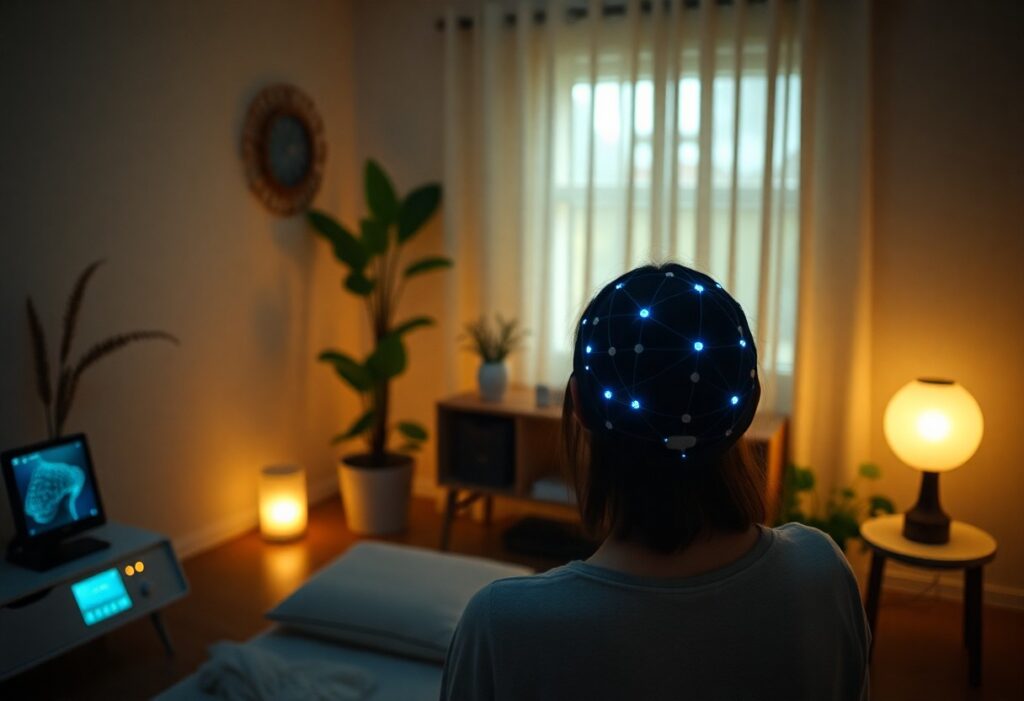With the increasing prevalence of mood disorders and emotional dysregulation, many are seeking effective, non-invasive solutions. Neurofeedback, a specialized form of biofeedback, can empower you to enhance your emotional resilience by training your brain to function more optimally. This approach allows you to gain real-time insights into your brain activity, making it possible for you to develop greater control over your emotions, reduce anxiety, and improve overall mood stability. In this post, discover how neurofeedback can be a valuable tool in managing emotional health and improving your quality of life.

Key Takeaways:
- Neurofeedback Training: This technique helps individuals learn to control their brain activity, leading to improved emotional regulation.
- Positive Outcomes: Evidence suggests that neurofeedback can reduce symptoms of mood disorders such as anxiety and depression.
- Personalized Approach: Neurofeedback sessions can be tailored to the specific needs of each individual, ensuring a more effective treatment for emotional issues.

Understanding Neurofeedback
Before delving into the specifics, it’s important to understand what neurofeedback truly means for emotional regulation and mood disorders.
Definition of Neurofeedback
Below, neurofeedback is defined as a type of biofeedback that uses real-time displays of brain activity to teach self-regulation of brain function. This innovative approach enables you to observe your brain’s performance, facilitating changes in mental states associated with various emotional and cognitive challenges.
Historical Background
After its inception, neurofeedback has evolved into a therapeutic modality with roots stretching back to the 1960s. It was initially researched as a method for enhancing cognitive performance and has gradually gained recognition for its efficacy in treating various psychological conditions, including mood disorders.
It is fascinating to note that the first neurofeedback experiments focused on operant conditioning, where individuals learned to control brainwave activities through feedback mechanisms. As research advanced, neurofeedback gained prominence as a non-invasive treatment approach, leading therapists and clients to explore its potential for emotional regulation and mental well-being.
Neurofeedback Mechanism
Among the foundation of neurofeedback techniques, understanding how it works can empower you in your mental health journey. Neurofeedback operates on the principle of operant conditioning; the brain is trained to improve its function by receiving feedback based on its activity.
Mechanism-wise, neurofeedback involves placing electrodes on your scalp to measure electrical activity. This data is translated into visual or auditory signals that you can interpret. For example, if your brain reaches a desired state, you might see a positive visual cue or hear rewarding sounds, reinforcing that state, which can improve your emotional regulation and mood over time.
Types of Neurofeedback Techniques
Neurofeedback offers various techniques tailored to meet your specific needs. Within the field, you can encounter several approaches, including:
- EEG Neurofeedback
- HEG Neurofeedback
- Functional MRI Neurofeedback
- Autogenic Training
- Biofeedback Integration
Recognizing the particular technique that suits your condition is important for maximizing the benefits.
Neurofeedback techniques can be categorized in a variety of ways. In understanding the spectrum of neurofeedback applications, consider the following:
| Technique | Description |
| EEG Neurofeedback | Focuses on brainwave patterns to promote cognitive improvements. |
| HEG Neurofeedback | Measures hemodynamic responses for emotional regulation. |
| fMRI Neurofeedback | Utilizes brain imaging to allow real-time brain function adjustments. |
| Autogenic Training | Focuses on self-induced relaxation and control of bodily functions. |
| Biofeedback Integration | Combines various biofeedback methods for comprehensive treatment. |
For instance, EEG neurofeedback is the most commonly employed technique and has shown promising results in treating anxiety and depression. Being informed about these diverse options allows you to engage meaningfully with your therapist, maximizing your chances of achieving emotional balance.
- Understanding your unique needs is key.
- Consulting with a licensed professional can provide tailored insights.
- Exploring multiple techniques may enhance your experience.
- Progress tracking is vital for evaluating effectiveness.
- Recognizing improvements can boost your motivation and commitment.
Emotional Regulation Explained
If you find yourself struggling to manage your emotions effectively, understanding emotional regulation is important. It involves the processes by which you monitor, evaluate, and respond to your emotional experiences. By developing these skills, you can influence your emotional state and cope better with life’s challenges.
Definition of Emotional Regulation
At its core, emotional regulation refers to your ability to manage and respond to your emotional experiences in a way that is appropriate and beneficial to your well-being. This can include recognizing when you’re feeling strong emotions, choosing how to express them, and adjusting your reactions based on the context.
Importance of Emotional Regulation
An effective emotional regulation strategy is key to maintaining your mental health. When you can handle your emotions well, you experience fewer mood swings and are less likely to engage in impulsive behaviors. This contributes to your overall emotional stability and resilience.
Emotional regulation protects your mental health by allowing you to respond to stressors in constructive ways. When you can effectively manage your emotional responses, you’re better equipped to face challenges, build supportive relationships, and navigate daily life with a clear mind. This capacity can lead to improved happiness and fulfillment.
How Emotional Regulation Affects Mental Health
One of the significant impacts of emotional regulation is on your mental health. Effective emotional regulation can help reduce symptoms of anxiety and depression, enabling you to experience a more balanced emotional life. When you harness your emotional responses, you gain the power to maintain your mental well-being.
Regulation of emotions directly influences your psychological state and overall quality of life. Those who struggle with emotional regulation often experience heightened anxiety, depressive symptoms, and interpersonal difficulties. By mastering emotional regulation, you can foster healthier relationships, cultivate a supportive internal dialogue, and promote a more resilient mindset.
Mood Disorders Overview
Your emotional well-being can be significantly influenced by mood disorders, which are mental health conditions that impact your emotional state, leading to prolonged periods of emotional distress. Research indicates that interventions like neurofeedback can be instrumental in Improving Emotion Regulation Through Real-Time Feedback, thereby aiding those who struggle with these disorders.
Definition of Mood Disorders
Between various sources, mood disorders are primarily categorized as mental health conditions that involve disturbances in your emotional state, resulting in prolonged and intense feelings of sadness, elation, or extreme mood fluctuations.
Types of Mood Disorders
Along with the general understanding of mood disorders, recognizing the specific types is vital for effective management. Commonly identified types include:
- Major Depressive Disorder
- Bipolar Disorder
- Persistent Depressive Disorder (Dysthymia)
- Cyclothymic Disorder
- Seasonal Affective Disorder (SAD)
Recognizing the signs and variations of these disorders can lead to better treatment and management options for you.
| Type of Mood Disorder | Description |
| Major Depressive Disorder | Severe despondency lasting for weeks or longer. |
| Bipolar Disorder | Characterized by alternating periods of depression and mania. |
| Persistent Depressive Disorder | Milder symptoms that last for years. |
| Cyclothymic Disorder | Persistent mood fluctuations that are less severe than bipolar disorder. |
| Seasonal Affective Disorder | Depression related to seasonal changes, often in winter. |
In fact, understanding the nuances between these different types can enhance your approach to treatment, as each may require tailored strategies and therapies.
Symptoms and Diagnosis
Definition of mood disorders encompasses various symptoms, including persistent sadness, fluctuating energy levels, and alterations in sleep patterns, which can vary significantly from one individual to another.
Disorders like these often manifest through distinct symptoms that can lead to various challenges in daily life. It is vital to seek professional evaluation when you notice shifts in your mood or emotional state that disrupt your ability to function effectively.
The Science Behind Neurofeedback and Emotional Regulation
After exploring the foundational concepts of neurofeedback, it’s important to probe the scientific principles that govern its effectiveness in emotional regulation and mood disorders. Understanding how your brain processes emotions and how neurofeedback can impact these processes will empower you to take an informed approach to your mental health.
Neural Basis of Emotions
One of the key insights in neuroscience is that emotions are closely linked to specific brain regions. Structures such as the amygdala, prefrontal cortex, and hippocampus interact dynamically to shape your emotional experiences. When these areas function optimally, you can maintain better emotional balance and cope with stress more effectively.
Neurofeedback’s Impact on Brain Function
Against this backdrop, neurofeedback emerges as a powerful tool for modifying brain function. By providing real-time feedback on your brain activity, it allows you to learn how to regulate the neural patterns associated with emotional responses, thereby enhancing your emotional self-regulation.
Emotions are influenced by your brain’s electrical activity, and neurofeedback aims to refine this activity by training you to achieve desired mental states. As you engage with this training, you can gradually learn to increase coherence in your brainwaves, resulting in improved emotional stability and resilience against mood fluctuations.
Studies Supporting Neurofeedback for Mood Disorders
Any exploration of neurofeedback’s efficacy is incomplete without considering the research. Numerous studies indicate that individuals with mood disorders can experience significant improvements in emotional regulation through neurofeedback training, often reporting enhanced well-being and decreased symptoms of anxiety and depression.
Supporting these claims, various clinical trials have demonstrated that neurofeedback not only reduces symptoms but also promotes lasting changes in brain function. These studies suggest that patients who undergo neurofeedback training often exhibit long-term benefits, including an increased ability to manage emotions effectively, indicating that the skills learned through neurofeedback can translate into everyday life. This transformative impact makes neurofeedback an appealing option for those seeking to improve their emotional well-being.
Neurofeedback in Practice
For those seeking to improve emotional regulation and manage mood disorders, neurofeedback therapy provides a structured and effective approach. Understanding how these sessions are conducted can help demystify the process and alleviate any concerns you may have.
How Neurofeedback Sessions are Conducted
An initial session typically involves an assessment where a technician evaluates your brainwave activity. During the therapy, sensors are placed on your scalp to monitor your brain’s electrical activity while you engage in specific tasks or watch videos. Feedback is provided in real-time, allowing you to learn how to regulate your brainwaves effectively.
Equipment and Technology Used
Practice involves specialized equipment designed to accurately measure and display your brain activity. This includes EEG sensors, which capture brainwave patterns, and software that interprets this data, translating it into visual or auditory feedback.
Further enhancing your neurofeedback experience, the technology used includes state-of-the-art EEG systems that offer precision in monitoring brainwave activity. The feedback can manifest as sounds or visual cues, allowing you to adjust your mental state in real-time, facilitating a more tailored approach to addressing your individual emotional challenges.
Commitment and Duration of Treatment
Above all, the effectiveness of neurofeedback often correlates with your commitment to the treatment plan. Typically, you might expect to engage in sessions once or twice a week, with the overall treatment duration varying based on personal goals and progress.
But consistency is key; many individuals start to notice improvements after several weeks of regular sessions. Each person’s journey is unique, and your tailor-made plan will consider your specific needs, guiding you toward lasting emotional regulation and improved mood stability.
Client Experiences and Testimonials
Practice shows that many clients have significant positive experiences with neurofeedback. They often report feeling more balanced emotionally, with lesser episodes of anxiety and depression following treatment.
Another important aspect is the testimonials shared by individuals who have undergone neurofeedback therapy. Many express a newfound sense of clarity and emotional resilience, highlighting it as a pivotal step in their mental health journey. Your experience could also become part of that narrative, reinforcing the potential benefits of this innovative approach.
Benefits of Neurofeedback for Emotional Regulation
Despite the various therapeutic options available, many individuals find that neurofeedback offers unique advantages for emotional regulation. This brainwave training technique enhances your self-awareness and ability to manage your emotions more effectively, resulting in improved mood stability and resilience.
Immediate Effects on Emotions
Behind the momentary changes observed during neurofeedback sessions, you may experience a rapid reduction in anxiety and stress. These immediate effects allow you to feel more grounded and in control of your emotional responses, setting the stage for further improvement.
Long-Term Changes and Benefits
With consistent practice, neurofeedback promotes significant long-term transformations in your emotional state. Over time, you can integrate the skills learned through the sessions, enhancing your ability to cope with daily stressors and reducing the occurrence of mood swings.
Immediate self-regulation becomes a habitual response as you train your brain to operate more effectively. This enhancement in emotional stability leads to a greater sense of well-being and a reduction in symptoms of mood disorders such as depression and anxiety. With dedicated practice, neurofeedback can empower you to harness emotional regulation in a meaningful way.
Comparisons to Traditional Therapies
Emotions can often feel overwhelming, but neurofeedback stands apart from traditional therapies by focusing directly on altering your brainwave patterns. Below is a comparison of neurofeedback and traditional therapies:
| Neurofeedback | Traditional Therapies |
| Focuses on brainwave modulation | Utilizes talking techniques and medication |
| Immediate feedback during sessions | May require multiple sessions for results |
| Cultivates self-regulation skills | Relies on therapist guidance |
Considering this contrast, neurofeedback may provide a faster and more direct route to emotional regulation. While traditional therapies are valuable, you may find that neurofeedback offers a more proactive approach. By actively training your brain, you can foster mastery over your emotional state and cultivate resilience effectively.
Considerations and Limitations of Neurofeedback
All forms of treatment, including neurofeedback, come with their own set of considerations and limitations. Understanding these aspects can help you make an informed decision about whether neurofeedback is a suitable choice for your emotional regulation and mood disorder needs. While many find neurofeedback beneficial, it is important to be aware of factors such as potential side effects, accessibility, cost, and the evolving nature of research in this area. For insights into Improving Emotion Regulation Through Real-Time Neurofeedback, exploring available literature can provide a deeper understanding of your options.
Potential Side Effects
Effects of neurofeedback can vary from person to person. While many individuals experience positive outcomes, some may encounter temporary discomfort, increased anxiety, or fatigue during or after sessions. These side effects are generally mild and diminish as you adjust to the process. It’s important to discuss any concerns with your practitioner to ensure the most effective approach.
Accessibility and Cost of Treatment
Limitations in access to neurofeedback programs and associated costs can pose challenges for some individuals. The availability of trained practitioners and equipment may vary by location, making it difficult for you to find suitable services nearby. Additionally, treatment costs may not be fully covered by insurance, requiring you to consider the financial commitment involved.
The landscape of neurofeedback treatment is marked by differing costs and availability, which can impact your decision-making. Session prices often range widely depending on the provider’s experience and the specific technology used. This means it’s important for you to research and possibly consult multiple practitioners to find an option that aligns with your budget and accessibility needs.
Ongoing Research and Future Directions
Around the field of neurofeedback, ongoing research is continually expanding our understanding of its mechanisms and effectiveness. As scientists explore various applications, including its role in emotional regulation and mood disorders, you may discover more tailored and efficient strategies for treatment in the future.
Further advancements in research will likely focus on refining training protocols, enhancing technology used in sessions, and understanding long-term effects. This evolving landscape may lead to more personalized approaches, allowing for better outcomes in managing your emotional regulation and mood disorder concerns. Keeping abreast of new findings can empower you to make informed treatment choices.
Conclusion
Considering all points, neurofeedback offers a promising avenue for enhancing your emotional regulation and managing mood disorders. By training your brain to optimize its function, you can experience improved emotional stability and resilience. Engaging with neurofeedback may allow you to better understand your brain’s activity and develop practical strategies for coping with anxiety and mood fluctuations. For more in-depth insights, you can explore Neurofeedback and Biofeedback for Mood and Anxiety …, which can guide you in your journey toward emotional balance.
FAQ
Q: What is neurofeedback and how does it work for emotional regulation?
A: Neurofeedback is a type of biofeedback that trains individuals to control their brain activity. Using real-time displays of brain activity, individuals learn to modify their brainwaves, which can lead to improved emotional regulation. By conditioning the brain to produce more of the desired brainwave patterns associated with calmness and focus, neurofeedback can help reduce symptoms of anxiety and mood disorders.
Q: Who can benefit from neurofeedback in terms of mood disorders?
A: Neurofeedback can benefit a wide range of individuals experiencing mood disorders, including those with anxiety, depression, PTSD, and bipolar disorder. It can be particularly helpful for individuals who have not found success with traditional therapies or medications, as well as those seeking complementary treatments to enhance their emotional resilience.
Q: How long does it take to see results from neurofeedback training?
A: The timeline for observing results from neurofeedback training can vary widely among individuals. Some people may notice improvements after just a few sessions, while others might require several weeks or months of consistent training. Factors influencing effectiveness include the severity of the mood disorder, personal commitment to the training process, and the specific neurofeedback protocols used.
Q: Are there any side effects associated with neurofeedback?
A: Neurofeedback is generally considered a safe and non-invasive treatment with minimal side effects. Some individuals may initially experience slight discomfort, fatigue, or emotional fluctuations as their brain adjusts to new patterns. However, these symptoms typically subside with continued training. It is vital to work with a qualified practitioner to ensure a positive experience.
Q: Can neurofeedback be used alongside other treatments for mood disorders?
A: Yes, neurofeedback can be effectively integrated with other therapeutic approaches, such as cognitive-behavioral therapy (CBT), medication, and mindfulness practices. This complementary approach can enhance overall treatment outcomes and provide individuals with a more comprehensive toolset for managing their emotional well-being.







